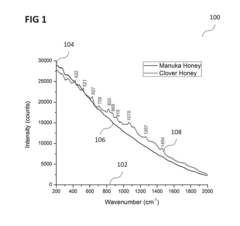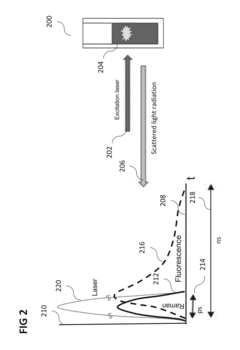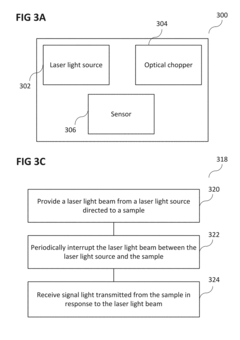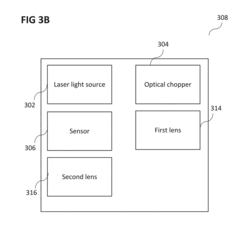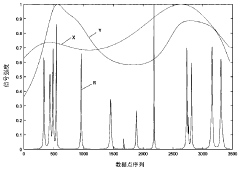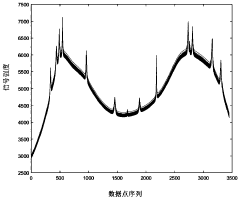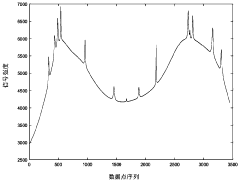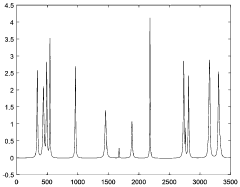How to Reduce Background Noise in Raman Spectroscopy
SEP 19, 20259 MIN READ
Generate Your Research Report Instantly with AI Agent
Patsnap Eureka helps you evaluate technical feasibility & market potential.
Raman Spectroscopy Noise Reduction Background and Objectives
Raman spectroscopy has evolved significantly since its discovery by C.V. Raman in 1928, becoming an essential analytical technique in various scientific and industrial applications. This non-destructive method provides detailed molecular fingerprints by analyzing inelastically scattered light, offering insights into chemical composition and molecular structure. Over the past decades, technological advancements have transformed Raman spectroscopy from a complex laboratory technique into a versatile tool deployed across pharmaceuticals, materials science, biomedical research, and environmental monitoring.
Despite its analytical power, Raman spectroscopy faces a persistent challenge: background noise that compromises signal quality and data interpretation. This background interference primarily stems from fluorescence, cosmic rays, detector noise, and thermal fluctuations. The weak nature of Raman scattering (approximately 1 in 10^7 photons undergo Raman scattering) makes the signal-to-noise ratio a critical factor limiting the technique's effectiveness in many applications.
The evolution of noise reduction approaches has paralleled the development of Raman instrumentation itself. Early systems relied on simple baseline correction methods, while modern solutions incorporate sophisticated hardware modifications and computational algorithms. Recent trends show increasing integration of machine learning and artificial intelligence to distinguish signal from noise in complex spectral data.
Current technological trajectories point toward miniaturization and portability of Raman systems, necessitating even more efficient noise reduction strategies that can operate with limited computational resources. Simultaneously, there is growing demand for real-time analysis capabilities across industries, requiring noise reduction techniques that can process data instantaneously without sacrificing accuracy.
The primary objectives of this technical research are multifaceted. First, we aim to comprehensively evaluate existing noise reduction methodologies in Raman spectroscopy, categorizing them by effectiveness, computational requirements, and application suitability. Second, we seek to identify emerging technologies and approaches that show promise for overcoming current limitations, particularly in challenging environments with high fluorescence backgrounds or low sample concentrations.
Additionally, this research intends to explore the potential for hybrid approaches that combine hardware modifications with advanced signal processing algorithms to achieve optimal noise reduction across diverse applications. We will assess the feasibility of implementing these solutions in next-generation portable and in-line Raman systems, considering factors such as power consumption, processing speed, and integration complexity.
Finally, we aim to establish a roadmap for future research and development efforts, highlighting critical technological gaps and potential breakthrough opportunities in Raman spectroscopy noise reduction. This will provide strategic guidance for prioritizing investment in specific technological approaches that align with market demands and scientific needs.
Despite its analytical power, Raman spectroscopy faces a persistent challenge: background noise that compromises signal quality and data interpretation. This background interference primarily stems from fluorescence, cosmic rays, detector noise, and thermal fluctuations. The weak nature of Raman scattering (approximately 1 in 10^7 photons undergo Raman scattering) makes the signal-to-noise ratio a critical factor limiting the technique's effectiveness in many applications.
The evolution of noise reduction approaches has paralleled the development of Raman instrumentation itself. Early systems relied on simple baseline correction methods, while modern solutions incorporate sophisticated hardware modifications and computational algorithms. Recent trends show increasing integration of machine learning and artificial intelligence to distinguish signal from noise in complex spectral data.
Current technological trajectories point toward miniaturization and portability of Raman systems, necessitating even more efficient noise reduction strategies that can operate with limited computational resources. Simultaneously, there is growing demand for real-time analysis capabilities across industries, requiring noise reduction techniques that can process data instantaneously without sacrificing accuracy.
The primary objectives of this technical research are multifaceted. First, we aim to comprehensively evaluate existing noise reduction methodologies in Raman spectroscopy, categorizing them by effectiveness, computational requirements, and application suitability. Second, we seek to identify emerging technologies and approaches that show promise for overcoming current limitations, particularly in challenging environments with high fluorescence backgrounds or low sample concentrations.
Additionally, this research intends to explore the potential for hybrid approaches that combine hardware modifications with advanced signal processing algorithms to achieve optimal noise reduction across diverse applications. We will assess the feasibility of implementing these solutions in next-generation portable and in-line Raman systems, considering factors such as power consumption, processing speed, and integration complexity.
Finally, we aim to establish a roadmap for future research and development efforts, highlighting critical technological gaps and potential breakthrough opportunities in Raman spectroscopy noise reduction. This will provide strategic guidance for prioritizing investment in specific technological approaches that align with market demands and scientific needs.
Market Analysis for High-Precision Raman Spectroscopy
The global market for high-precision Raman spectroscopy is experiencing robust growth, driven by increasing demand across pharmaceutical, biomedical, and materials science sectors. Current market valuations place the high-precision Raman spectroscopy segment at approximately 1.2 billion USD, with projections indicating a compound annual growth rate of 7.8% through 2028.
The pharmaceutical industry represents the largest market share, accounting for nearly 35% of total demand. This dominance stems from stringent quality control requirements and the need for non-destructive analytical methods in drug development and manufacturing processes. The ability to detect trace contaminants and verify molecular structures makes high-precision Raman systems particularly valuable in this sector.
Academic and research institutions constitute the second-largest market segment at 28%, where advanced Raman systems are essential for cutting-edge materials research, biological studies, and nanotechnology development. The demand for systems with superior background noise reduction capabilities is especially pronounced in this segment, as researchers push the boundaries of detection limits.
Geographically, North America leads the market with approximately 38% share, followed by Europe (31%) and Asia-Pacific (24%). The Asia-Pacific region, particularly China and India, demonstrates the fastest growth trajectory, with annual expansion rates exceeding 10% due to increasing investment in pharmaceutical manufacturing and research infrastructure.
Market analysis reveals a clear correlation between background noise reduction capabilities and market premium. Systems offering superior signal-to-noise ratios command price premiums of 30-45% compared to standard models, highlighting the significant market value placed on this technical feature.
Customer surveys indicate that 76% of end-users rank background noise reduction as either "very important" or "critical" when evaluating Raman spectroscopy equipment purchases. This preference is particularly strong among users working with biological samples, dilute solutions, and fluorescent materials where background interference presents significant analytical challenges.
The competitive landscape shows increasing specialization, with market leaders focusing on proprietary noise reduction technologies as key differentiators. Recent market trends indicate growing demand for portable and handheld devices with laboratory-grade noise reduction capabilities, opening new application areas in field testing, quality control, and point-of-care diagnostics.
Market forecasts suggest that innovations specifically addressing background noise reduction could unlock an additional 300 million USD in market value by 2026, primarily by enabling new applications in previously challenging sample types and expanding the user base beyond traditional laboratory settings.
The pharmaceutical industry represents the largest market share, accounting for nearly 35% of total demand. This dominance stems from stringent quality control requirements and the need for non-destructive analytical methods in drug development and manufacturing processes. The ability to detect trace contaminants and verify molecular structures makes high-precision Raman systems particularly valuable in this sector.
Academic and research institutions constitute the second-largest market segment at 28%, where advanced Raman systems are essential for cutting-edge materials research, biological studies, and nanotechnology development. The demand for systems with superior background noise reduction capabilities is especially pronounced in this segment, as researchers push the boundaries of detection limits.
Geographically, North America leads the market with approximately 38% share, followed by Europe (31%) and Asia-Pacific (24%). The Asia-Pacific region, particularly China and India, demonstrates the fastest growth trajectory, with annual expansion rates exceeding 10% due to increasing investment in pharmaceutical manufacturing and research infrastructure.
Market analysis reveals a clear correlation between background noise reduction capabilities and market premium. Systems offering superior signal-to-noise ratios command price premiums of 30-45% compared to standard models, highlighting the significant market value placed on this technical feature.
Customer surveys indicate that 76% of end-users rank background noise reduction as either "very important" or "critical" when evaluating Raman spectroscopy equipment purchases. This preference is particularly strong among users working with biological samples, dilute solutions, and fluorescent materials where background interference presents significant analytical challenges.
The competitive landscape shows increasing specialization, with market leaders focusing on proprietary noise reduction technologies as key differentiators. Recent market trends indicate growing demand for portable and handheld devices with laboratory-grade noise reduction capabilities, opening new application areas in field testing, quality control, and point-of-care diagnostics.
Market forecasts suggest that innovations specifically addressing background noise reduction could unlock an additional 300 million USD in market value by 2026, primarily by enabling new applications in previously challenging sample types and expanding the user base beyond traditional laboratory settings.
Current Challenges in Raman Background Noise Suppression
Raman spectroscopy faces persistent challenges in background noise suppression that significantly impact measurement accuracy and reliability. The most prominent issue is fluorescence interference, which can overwhelm the relatively weak Raman signals by several orders of magnitude. This fluorescence originates from the sample matrix or impurities and creates broad spectral backgrounds that mask critical Raman peaks, particularly problematic in biological samples and natural materials.
Instrument-related noise presents another major challenge, including detector dark current noise, readout noise, and thermal fluctuations. Modern CCD detectors, while sensitive, introduce shot noise that becomes particularly problematic during long acquisition times needed for weak Raman signals. Additionally, cosmic ray spikes randomly appear as sharp intensity peaks, creating false positives that complicate automated analysis.
Environmental factors further compound these challenges. Ambient light leakage into the optical path, temperature variations affecting both sample and instrumentation, and mechanical vibrations all contribute to measurement instability. These environmental interferences are especially problematic in field applications or industrial settings where controlled laboratory conditions cannot be maintained.
Sample-specific issues represent another category of challenges. Sample heterogeneity leads to inconsistent signal intensity across measurement points, while sample heating from laser exposure can cause thermal emissions that contribute to background noise. Photodegradation during measurement further complicates matters by changing the sample's optical properties over time.
The computational aspects of noise suppression introduce their own difficulties. Current algorithms for baseline correction often struggle with complex, non-linear backgrounds typical in real-world samples. Many approaches require manual parameter tuning, introducing subjectivity and reducing reproducibility across different operators and laboratories. The trade-off between noise reduction and signal preservation remains a fundamental challenge, as aggressive noise filtering techniques frequently distort peak shapes and intensities.
Emerging applications in low-concentration analytics, nanomaterial characterization, and in-vivo measurements are pushing the limits of current noise suppression techniques. The demand for real-time analysis in industrial quality control and medical diagnostics further constrains processing time, requiring more efficient algorithms that can operate with minimal computational resources while maintaining accuracy.
These multifaceted challenges necessitate an integrated approach to background noise reduction that combines advances in instrumentation, sample preparation methodologies, and computational techniques to enhance the signal-to-noise ratio in Raman spectroscopy.
Instrument-related noise presents another major challenge, including detector dark current noise, readout noise, and thermal fluctuations. Modern CCD detectors, while sensitive, introduce shot noise that becomes particularly problematic during long acquisition times needed for weak Raman signals. Additionally, cosmic ray spikes randomly appear as sharp intensity peaks, creating false positives that complicate automated analysis.
Environmental factors further compound these challenges. Ambient light leakage into the optical path, temperature variations affecting both sample and instrumentation, and mechanical vibrations all contribute to measurement instability. These environmental interferences are especially problematic in field applications or industrial settings where controlled laboratory conditions cannot be maintained.
Sample-specific issues represent another category of challenges. Sample heterogeneity leads to inconsistent signal intensity across measurement points, while sample heating from laser exposure can cause thermal emissions that contribute to background noise. Photodegradation during measurement further complicates matters by changing the sample's optical properties over time.
The computational aspects of noise suppression introduce their own difficulties. Current algorithms for baseline correction often struggle with complex, non-linear backgrounds typical in real-world samples. Many approaches require manual parameter tuning, introducing subjectivity and reducing reproducibility across different operators and laboratories. The trade-off between noise reduction and signal preservation remains a fundamental challenge, as aggressive noise filtering techniques frequently distort peak shapes and intensities.
Emerging applications in low-concentration analytics, nanomaterial characterization, and in-vivo measurements are pushing the limits of current noise suppression techniques. The demand for real-time analysis in industrial quality control and medical diagnostics further constrains processing time, requiring more efficient algorithms that can operate with minimal computational resources while maintaining accuracy.
These multifaceted challenges necessitate an integrated approach to background noise reduction that combines advances in instrumentation, sample preparation methodologies, and computational techniques to enhance the signal-to-noise ratio in Raman spectroscopy.
Contemporary Noise Reduction Methodologies and Algorithms
01 Background noise reduction techniques in Raman spectroscopy
Various techniques can be employed to reduce background noise in Raman spectroscopy measurements. These include mathematical algorithms, signal processing methods, and hardware adjustments that help to isolate the Raman signal from unwanted background interference. By implementing these noise reduction techniques, the signal-to-noise ratio can be significantly improved, leading to more accurate spectral analysis and interpretation.- Background noise reduction techniques in Raman spectroscopy: Various techniques can be employed to reduce background noise in Raman spectroscopy, including mathematical algorithms, signal processing methods, and hardware optimizations. These approaches help to isolate the Raman signal from fluorescence and other background interferences, improving the signal-to-noise ratio and enhancing the quality of spectral data. Advanced computational methods such as baseline correction algorithms and wavelet transforms can effectively separate the Raman signal from unwanted background noise.
- Fluorescence suppression methods: Fluorescence is a major source of background noise in Raman spectroscopy that can overwhelm the weaker Raman signals. Techniques for fluorescence suppression include time-gated detection, shifted-excitation Raman difference spectroscopy (SERDS), and the use of specific wavelengths for excitation. These methods exploit the different temporal characteristics of Raman scattering and fluorescence or utilize multiple excitation wavelengths to isolate the Raman signal from fluorescence background, resulting in cleaner spectra with improved analytical capabilities.
- Hardware-based solutions for noise reduction: Specialized hardware components can significantly reduce background noise in Raman spectroscopy systems. These include confocal optical arrangements, specialized filters, cooled detectors, and optimized optical configurations. Confocal designs limit the collection volume, reducing unwanted signals from outside the focal plane. Temperature-controlled detectors minimize thermal noise, while specialized notch filters and edge filters effectively block Rayleigh scattered light while allowing Raman scattered light to pass through, resulting in improved spectral quality.
- Machine learning and AI approaches for background correction: Advanced computational methods utilizing machine learning and artificial intelligence are increasingly being applied to address background noise in Raman spectroscopy. These approaches include neural networks, deep learning algorithms, and pattern recognition techniques that can automatically identify and subtract background contributions from Raman spectra. These methods can adapt to different sample types and experimental conditions, providing more robust and automated background correction compared to traditional methods.
- Sample preparation and measurement protocols to minimize background noise: Optimized sample preparation techniques and measurement protocols can significantly reduce background noise in Raman spectroscopy. These include surface-enhanced Raman spectroscopy (SERS), resonance Raman techniques, and specialized sample holders or substrates. Proper selection of laser power, exposure time, and accumulation parameters can help minimize sample degradation and associated background noise. Additionally, environmental control measures such as temperature regulation and ambient light exclusion can further improve signal quality by reducing external interference sources.
02 Fluorescence background suppression methods
Fluorescence is a common source of background noise in Raman spectroscopy that can overwhelm the weaker Raman signals. Suppression methods include time-gated detection, shifted-excitation techniques, and specialized wavelength selection. These approaches help to separate the fluorescence background from the Raman signal, allowing for clearer spectral data collection even from samples with high fluorescence properties.Expand Specific Solutions03 Hardware-based solutions for background noise minimization
Specialized hardware configurations can be implemented to minimize background noise in Raman spectroscopy systems. These include confocal optical arrangements, specialized filters, optimized detector cooling systems, and improved spectrometer designs. Such hardware modifications can significantly reduce unwanted signals from ambient light, cosmic rays, and thermal noise, resulting in cleaner Raman spectra with improved detection limits.Expand Specific Solutions04 Machine learning and AI approaches for noise filtering
Advanced computational methods utilizing machine learning and artificial intelligence can be applied to process Raman spectroscopy data and filter out background noise. These algorithms can learn to distinguish between noise patterns and actual Raman signals, automatically removing unwanted background components. Neural networks and other AI techniques can be particularly effective for complex samples where traditional filtering methods may be insufficient.Expand Specific Solutions05 Calibration and reference standards for background correction
Proper calibration procedures and the use of reference standards are essential for accurate background correction in Raman spectroscopy. These methods involve measuring known reference materials to establish baseline corrections and develop standardized protocols for background subtraction. By implementing systematic calibration approaches, variations in instrument response and environmental conditions can be accounted for, leading to more consistent and comparable Raman spectra across different measurements.Expand Specific Solutions
Leading Manufacturers and Research Institutions in Raman Technology
The Raman spectroscopy background noise reduction market is in a growth phase, with increasing adoption across pharmaceutical, materials science, and biomedical applications. The global Raman spectroscopy market is projected to reach approximately $2.5 billion by 2025, with noise reduction technologies representing a critical segment. Leading companies demonstrate varying levels of technical maturity: Thermo Fisher Scientific, Renishaw, and Horiba offer advanced commercial solutions with proprietary algorithms, while Intel and Hitachi contribute computing innovations. Academic institutions like University of Nottingham, Friedrich Schiller University, and Gwangju Institute of Science & Technology are pioneering novel approaches through machine learning and hardware modifications. Chinese players including Optosky Xiamen Photonics and NUCTECH are rapidly advancing with cost-effective solutions, indicating a competitive landscape transitioning from specialized instrumentation to integrated software-hardware systems.
Renishaw Plc
Technical Solution: Renishaw has developed comprehensive noise reduction solutions for Raman spectroscopy through their WiRE (Windows-based Raman Environment) software platform. Their approach combines hardware and software innovations including: 1) Confocal optical design that spatially filters out-of-focus light, significantly reducing fluorescence background from sample volumes outside the focal point[1]. 2) Automated baseline correction algorithms that model and subtract background fluorescence using polynomial fitting and advanced statistical methods. 3) Implementation of Cosmic Ray Removal (CRR) technology that automatically identifies and removes sharp spike artifacts caused by cosmic rays hitting the detector during measurement[2]. 4) Signal averaging techniques that improve signal-to-noise ratio proportionally to the square root of the number of accumulations. 5) Their patented SynchroScan™ technology enables continuous scanning during extended acquisitions, minimizing sample exposure and reducing photodegradation-related background noise[3].
Strengths: Industry-leading confocal design provides superior spatial filtering of background signals. Proprietary algorithms offer excellent automated background correction without distorting spectral features. Weaknesses: Premium pricing makes solutions less accessible to budget-constrained laboratories. Some advanced noise reduction features require significant computational resources, potentially slowing analysis of large datasets.
Thermo Electron Scientific Instruments LLC
Technical Solution: Thermo Scientific has pioneered multiple approaches to background noise reduction in Raman spectroscopy, implementing a multi-layered strategy in their DXR and iXR Raman systems. Their technology includes: 1) Patented automatic fluorescence rejection system that utilizes photobleaching protocols optimized for different sample types to reduce fluorescence before measurement begins[1]. 2) Advanced CCD detector cooling systems (down to -90°C) that dramatically reduce thermal noise (dark current) by approximately 50% for every 8-10°C of cooling[2]. 3) Implementation of Shifted Excitation Raman Difference Spectroscopy (SERDS) that uses slightly different laser wavelengths to acquire two spectra where Raman peaks shift while background remains constant, allowing computational separation[3]. 4) OMNIC™ software suite featuring proprietary algorithms for automated baseline correction and smoothing functions that preserve spectral integrity while removing background interference. 5) Multivariate statistical methods including Principal Component Analysis (PCA) to isolate and remove systematic background variations across multiple samples.
Strengths: Comprehensive suite of both hardware and software solutions provides flexibility for different sample types. Industry-leading detector cooling technology significantly reduces thermal noise components. Weaknesses: Some advanced noise reduction techniques require multiple measurements of the same sample, increasing total analysis time. Implementation of certain algorithms requires specialized training and expertise for optimal results.
Key Patents and Innovations in Spectral Signal Processing
Raman spectroscopy systems and raman spectroscopy methods
PatentInactiveUS10215630B2
Innovation
- A Raman spectroscopy system and method utilizing a high-speed optical spin-disk or optical chopper to create time-gated short pulses, allowing only the Raman signal to pass through while blocking most of the fluorescence, using a continuous wave laser and regular sensors to reduce setup complexity and cost.
Method for eliminating Raman spectrum background by adopting arithmetic mean and geometric mean difference
PatentActiveCN110889368A
Innovation
- The arithmetic mean and geometric mean difference methods are used to extract Raman spectrum elements from the spectra collected multiple times. By calculating the difference between the arithmetic mean and the geometric mean, the Raman spectrum and the background signal are separated, and accumulated or averaged to obtain a background-free Spectrum after interference.
Regulatory Standards for Spectroscopic Measurement Accuracy
Regulatory standards for spectroscopic measurement accuracy play a crucial role in ensuring reliable Raman spectroscopy results across various industries. These standards establish the minimum requirements for measurement precision, calibration procedures, and acceptable noise levels that must be met by analytical instruments and methodologies. The International Organization for Standardization (ISO) has developed several standards specifically addressing spectroscopic techniques, including ISO 17025 which provides general requirements for the competence of testing and calibration laboratories.
The American Society for Testing and Materials (ASTM) has established ASTM E1840, which outlines standard practices for Raman spectroscopy, including guidelines for signal-to-noise ratios and spectral resolution. This standard specifically addresses background noise reduction requirements, mandating that systems must demonstrate the ability to distinguish analyte signals from background interference with statistical confidence.
In pharmaceutical applications, regulatory bodies such as the FDA and EMA have implemented Good Manufacturing Practice (GMP) guidelines that include specific requirements for analytical method validation. These guidelines require demonstration of method specificity, which directly relates to the ability to separate Raman signals from background noise. ICH Q2(R1) guidelines specifically address validation parameters including detection limits, which are heavily influenced by background noise levels.
For environmental monitoring applications, the EPA has established Method TO-16, which includes performance criteria for spectroscopic techniques used in air quality monitoring. These standards specify maximum allowable background interference levels and minimum detection capabilities for various compounds of interest.
The National Institute of Standards and Technology (NIST) provides Standard Reference Materials (SRMs) specifically designed for Raman spectroscopy calibration and validation. These materials allow laboratories to verify their instruments' performance against established benchmarks, including background noise levels and signal recovery capabilities.
In clinical diagnostics, the Clinical Laboratory Improvement Amendments (CLIA) regulations establish quality standards for laboratory testing, including spectroscopic methods. These regulations require laboratories to implement quality control procedures that address background noise reduction and signal verification to ensure accurate diagnostic results.
Compliance with these regulatory standards often requires implementation of specific noise reduction techniques, regular system performance verification, and thorough documentation of data processing methodologies. Many standards are moving toward requiring automated background subtraction algorithms to be validated separately from the primary analytical method, ensuring transparency in how spectral data is processed and interpreted.
The American Society for Testing and Materials (ASTM) has established ASTM E1840, which outlines standard practices for Raman spectroscopy, including guidelines for signal-to-noise ratios and spectral resolution. This standard specifically addresses background noise reduction requirements, mandating that systems must demonstrate the ability to distinguish analyte signals from background interference with statistical confidence.
In pharmaceutical applications, regulatory bodies such as the FDA and EMA have implemented Good Manufacturing Practice (GMP) guidelines that include specific requirements for analytical method validation. These guidelines require demonstration of method specificity, which directly relates to the ability to separate Raman signals from background noise. ICH Q2(R1) guidelines specifically address validation parameters including detection limits, which are heavily influenced by background noise levels.
For environmental monitoring applications, the EPA has established Method TO-16, which includes performance criteria for spectroscopic techniques used in air quality monitoring. These standards specify maximum allowable background interference levels and minimum detection capabilities for various compounds of interest.
The National Institute of Standards and Technology (NIST) provides Standard Reference Materials (SRMs) specifically designed for Raman spectroscopy calibration and validation. These materials allow laboratories to verify their instruments' performance against established benchmarks, including background noise levels and signal recovery capabilities.
In clinical diagnostics, the Clinical Laboratory Improvement Amendments (CLIA) regulations establish quality standards for laboratory testing, including spectroscopic methods. These regulations require laboratories to implement quality control procedures that address background noise reduction and signal verification to ensure accurate diagnostic results.
Compliance with these regulatory standards often requires implementation of specific noise reduction techniques, regular system performance verification, and thorough documentation of data processing methodologies. Many standards are moving toward requiring automated background subtraction algorithms to be validated separately from the primary analytical method, ensuring transparency in how spectral data is processed and interpreted.
Cost-Benefit Analysis of Advanced Noise Reduction Solutions
When evaluating advanced noise reduction solutions for Raman spectroscopy, a comprehensive cost-benefit analysis is essential to determine the most economically viable approaches. The initial investment for sophisticated hardware solutions such as confocal Raman systems ranges from $50,000 to $200,000, representing a significant capital expenditure. However, these systems can reduce background noise by up to 90%, dramatically improving spectral quality and enabling detection of previously obscured Raman signals.
Software-based solutions present a more accessible entry point, with commercial packages typically priced between $5,000 and $20,000. While these solutions offer noise reduction capabilities of 40-70%, they can be implemented on existing hardware, avoiding the need for complete system replacement. The return on investment typically manifests within 12-18 months through improved analytical accuracy and reduced need for sample reprocessing.
Time-gated Raman systems, though expensive at $100,000-$300,000, deliver exceptional performance in fluorescence-heavy applications, potentially opening new revenue streams in previously challenging analytical scenarios. Organizations must consider not only the direct costs but also indirect expenses such as staff training, which typically requires 20-40 hours per technician, and potential downtime during implementation.
Maintenance costs vary significantly across solutions, with hardware-intensive approaches requiring annual service contracts of approximately 10-15% of the initial investment. Conversely, software solutions generally incur lower maintenance costs at 15-25% of purchase price, primarily for updates and technical support.
The economic benefits extend beyond improved data quality. Enhanced noise reduction capabilities can reduce analysis time by 30-50%, increase sample throughput, and minimize reagent consumption. For commercial laboratories, this translates to handling more samples with existing resources, potentially increasing revenue by 15-25% without proportional cost increases.
When evaluating long-term value, consideration must be given to scalability and future compatibility. Open-architecture systems that allow modular upgrades typically demonstrate better long-term value despite higher initial costs. The expected useful life of hardware solutions (7-10 years) versus software solutions (3-5 years before major updates) should factor into depreciation calculations and total cost of ownership analyses.
For research institutions and industrial laboratories with diverse analytical needs, the ability to repurpose noise reduction technologies across multiple spectroscopic techniques represents an additional economic advantage that should be quantified in the decision-making process.
Software-based solutions present a more accessible entry point, with commercial packages typically priced between $5,000 and $20,000. While these solutions offer noise reduction capabilities of 40-70%, they can be implemented on existing hardware, avoiding the need for complete system replacement. The return on investment typically manifests within 12-18 months through improved analytical accuracy and reduced need for sample reprocessing.
Time-gated Raman systems, though expensive at $100,000-$300,000, deliver exceptional performance in fluorescence-heavy applications, potentially opening new revenue streams in previously challenging analytical scenarios. Organizations must consider not only the direct costs but also indirect expenses such as staff training, which typically requires 20-40 hours per technician, and potential downtime during implementation.
Maintenance costs vary significantly across solutions, with hardware-intensive approaches requiring annual service contracts of approximately 10-15% of the initial investment. Conversely, software solutions generally incur lower maintenance costs at 15-25% of purchase price, primarily for updates and technical support.
The economic benefits extend beyond improved data quality. Enhanced noise reduction capabilities can reduce analysis time by 30-50%, increase sample throughput, and minimize reagent consumption. For commercial laboratories, this translates to handling more samples with existing resources, potentially increasing revenue by 15-25% without proportional cost increases.
When evaluating long-term value, consideration must be given to scalability and future compatibility. Open-architecture systems that allow modular upgrades typically demonstrate better long-term value despite higher initial costs. The expected useful life of hardware solutions (7-10 years) versus software solutions (3-5 years before major updates) should factor into depreciation calculations and total cost of ownership analyses.
For research institutions and industrial laboratories with diverse analytical needs, the ability to repurpose noise reduction technologies across multiple spectroscopic techniques represents an additional economic advantage that should be quantified in the decision-making process.
Unlock deeper insights with Patsnap Eureka Quick Research — get a full tech report to explore trends and direct your research. Try now!
Generate Your Research Report Instantly with AI Agent
Supercharge your innovation with Patsnap Eureka AI Agent Platform!
